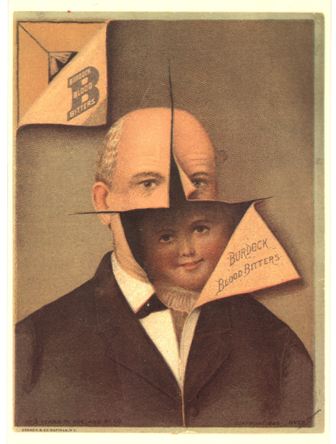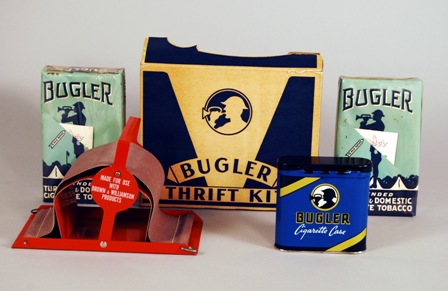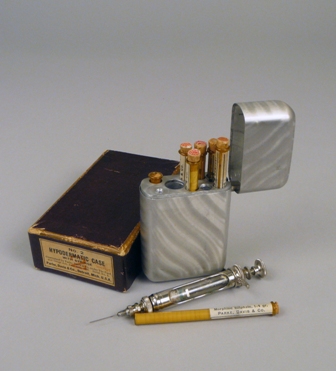NLM Announces "Pick Your Poison: Intoxicating Pleasures and Medical Prescriptions," on Display through April 12, 2013
The National Library of Medicine, the world's largest medical library and a component of the National Institutes of Health, is pleased to announce a new special display, Pick Your Poison: Intoxicating Pleasures and Medical Prescriptions. This unique project, featuring items from the National Library of Medicine's historical collection as well as the National Museum of American History in Washington, DC, is open to the public in the History of Medicine Division Reading Room (Building 38, first floor), on the NIH campus in Bethesda, Maryland, through April 12, 2013. Visitors are welcome between 8:30 AM and 5:00 PM weekdays except federal holidays.
Mind-altering drugs have been used throughout the history of America. While some remain socially acceptable, such as alcohol, others, like heroin and cocaine, are now outlawed because of their toxic, and intoxicating, characteristics. These classifications have shifted at different times in history, and they will continue to change.
The transformation of a particular drug, from an acceptable indulgence or medical treatment to a bad habit, or vice versa, is closely tied to the intentions and their status in society of those endorsing its use. Yet these substances have often served the same ends whether administered for prescription or for pleasure—to treat pain and illness, to ease the hardships of work and daily life, or to feed an addiction.
Pick Your Poison explores some of the factors that have shaped the changing definition of some of our most potent drugs in a special display featuring rare books and ephemera from the collection of the National Library of Medicine, historic artifacts from the National Museum of American History, and photographs from the Library of Congress.
In conjunction with this special display, the History of Medicine Division Lecture Series is presenting Frederick W. Gibbs, PhD, Assistant Professor of History, Department of History and Art History and Director of Digital Scholarship, Center for History and New Media at George Mason University, speaking on the topic "'The Venoms Doo Cure the Diseases:' Separating Poison and Medicine in Early Modern Europe." The lecture takes place in the Lister Hill Auditorium, Building 38A on Wednesday, September 26, 2012 at 2:00pm to 3:00pm. All are invited.
For a tour of the special display at NLM in Bethesda, please contact: NLMExhibition@mail.nih.gov; or call 301.594.1947.

Advertisement for the invigorating benefits of Burdock Blood Bitters, ca. 1880
Courtesy National Library of Medicine
Manufacturers of patent medicines, which were sold directly to the public, marketed temperance drinks as healthful tonics good for everything from restoring youthful energy to treating malaria. In fact, many of these products, such as Burdock Blood Bitters, were loaded with as much as twenty percent alcohol.

Maxfield Parrish, No-To-Bac advertisement, ca. 1900 (reproduction 1986)
Courtesy National Library of Medicine
No-To-Bac, a chewing gum containing licorice, plant materials, and salt, was one of several products marketed as a cure to the tobacco habit. The remedy was marketed to men, the main users of tobacco at the time, as a means to restore manly vigor and virility imperiled by nicotine use.

Bugler Thrift Kit for Hand-Rolling Cigarettes, Brown and Williamson Tobacco Corp., after 1930
Courtesy National Museum of American History
In the Great Depression, the Bugler Thrift Kit, with its military imagery, was marketed as a cheap alternative to pre-made cigarettes.

Coryza Bell morphine tablets, Hollings-Smith Co.
Courtesy National Museum of American History
American physicians began widely prescribing morphine, an alkaloid of opium, in the middle of the 19th century. Doctors dispensed morphine pills and powders to Civil War soldiers and veterans.

Physician's hypodermic needle kit with morphine, Parke, Davis & Co., 1908-1918
Courtesy National Museum of American History
American physicians began widely prescribing morphine, an alkaloid of opium, in the middle of the 19th century. Following the introduction of the hypodermic syringe, brought to America in 1856, morphine use and addiction increased. Doctors injected middle- and upper-class women for the treatment of so-called female troubles, such as nervousness and lethargy. Women soon became the major proportion of those addicted.

Hooked!, an anti-drug comic book presenting marijuana as a gateway to heroin, social ruin, and death, 1967
Courtesy National Library of Medicine
In the 1960s, scientists' general observations of the widespread social use of cannabis suggested the substance might be less harmful than once believed. As a result, public health messages shifted from the risks of the drug itself, to the idea that it might serve as a "gateway" to other, more dangerous psychoactive substances.
